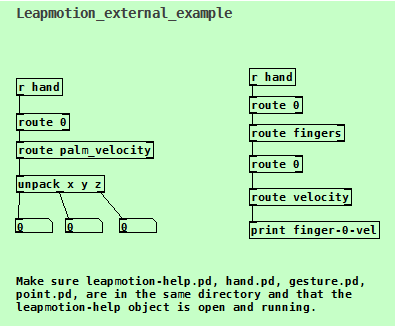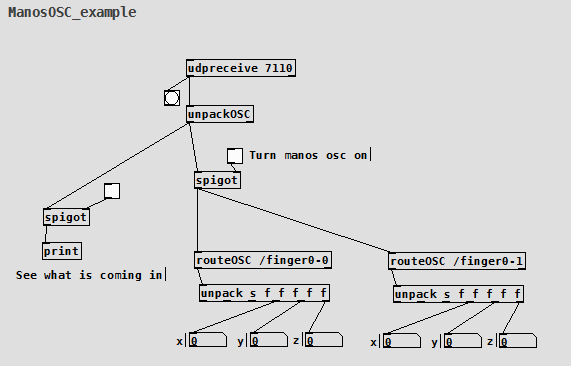Tutorial: Leap Motion to PureData
|
Introduction The Leap Motion is a sensor that can be used to read hand gestures. It provides spatial coordinates from each joint on each finger. If you’re interested in using the Leap Motion sensor with puredata to control sound through gesture, this tutorial will provide a guide for doing so. Leap Motion Setup: Follow the instructions here: https://www.leapmotion.com/setup. You don’t need to get the developer version if you are just using it with puredata, but it could be useful for other projects. Mac users: There is a pd external found here: http://puredatajapan.info/?page_id=1514 that reads the leap motion data and also provides some other useful calculations other than just spatial coordinates (velocities, palm normals, etc). This can be used in any of your own patches. Once it is compiled on your computer, copy the leapmotion-help.pd file, along with gesture.pd, hand.pd, and point.pd into the the same directory as your patch. Create a leapmotion-help object in your patch, and open it up so it is running at the same time. You’ll notice that the leapmotion-help patch is using the puredata send objects to send data about hands/gestures/general info/tools. In your own patch, you can receive these messages using the receive object with the name of what you want. You can print these messages to see how they are formatted and then use several route and unpack objects to get the exact values you want. An example for getting the velocity of a hand is shown below, and for getting the “first” finger’s velocity. Alternatives: I used the ManosOSC app available on the leap motion app store (https://apps.leapmotion.com/apps/manososc). This app streams OpenSoundControl data that pd can get through a UDP connection. This uses the mrpeach library just like the tutorials on using the smartphone apps to send OSC data. Just make sure to change the port to port to the same one that the ManosOSC app is sending on. The default is 7110.The example below is for getting the xyz coordinates of the tips of the first two fingers the leapmotion recognizes.
The actual pd file with the code in the screenshots can be found here: https://github.com/aditisar/oobleck/blob/master/leappdtutorial.pd My final project used ManosOSC and tried to track a finger’s direction to control frequency/amplitude of a speaker. The code for that can be found here: https://github.com/aditisar/oobleck/blob/master/finalproject.pd |


